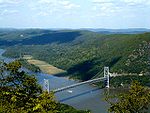The Hudson River is a 315-mile (507 km) river that flows from north to south primarily through eastern New York in the United States. It originates in the Adirondack Mountains of Upstate New York and flows southward through the Hudson Valley to the Upper New York Bay between New York City and Jersey City, eventually draining into the Atlantic Ocean at New York Harbor. The river serves as a political boundary between the states of New Jersey and New York at its southern end. Farther north, it marks local boundaries between several New York counties. The lower half of the river is a tidal estuary, deeper than the body of water into which it flows, occupying the Hudson Fjord, an inlet which formed during the most recent period of North American glaciation, estimated at 26,000 to 13,300 years ago. Even as far north as the city of Troy, the flow of the river changes direction with the tides.
The Hudson River runs through the Munsee/Lenape, Mohican, and Mohawk, Haudenosaunee homelands. Prior to European exploration, the river was known as the Mahicannittuk by the Mohicans, Ka'nón:no by the Mohawks, and Muhheakantuck by the Lenape. The river was subsequently named after Henry Hudson, an Englishman sailing for the Dutch East India Company who explored it in 1609, and after whom Hudson Bay in Canada is also named. It had previously been observed by Italian explorer Giovanni da Verrazzano sailing for King Francis I of France in 1524, as he became the first European known to have entered the Upper New York Bay, but he considered the river to be an estuary. The Dutch called the river the North River—with the Delaware River called the South River—and it formed the spine of the Dutch colony of New Netherland. Settlements of the colony clustered around the Hudson, and its strategic importance as the gateway to the American interior led to years of competition between the English and the Dutch over control of the river and colony.
During the eighteenth century, the river valley and its inhabitants were the subject and inspiration of Washington Irving, the first internationally acclaimed American author. In the nineteenth century, the area inspired the Hudson River School of landscape painting, an American pastoral style, as well as the concepts of environmentalism and wilderness. The Hudson was also the eastern outlet for the Erie Canal, which, when completed in 1825, became an important transportation artery for the early 19th century United States.
Pollution in the river increased in the 20th century, more acutely by mid-century, particularly with industrial contamination from polychlorinated biphenyls (PCBs). Pollution control regulations, enforcement actions and restoration projects initiated in the latter 20th century have begun to improve water quality, and restoration work has continued in the 21st century.









